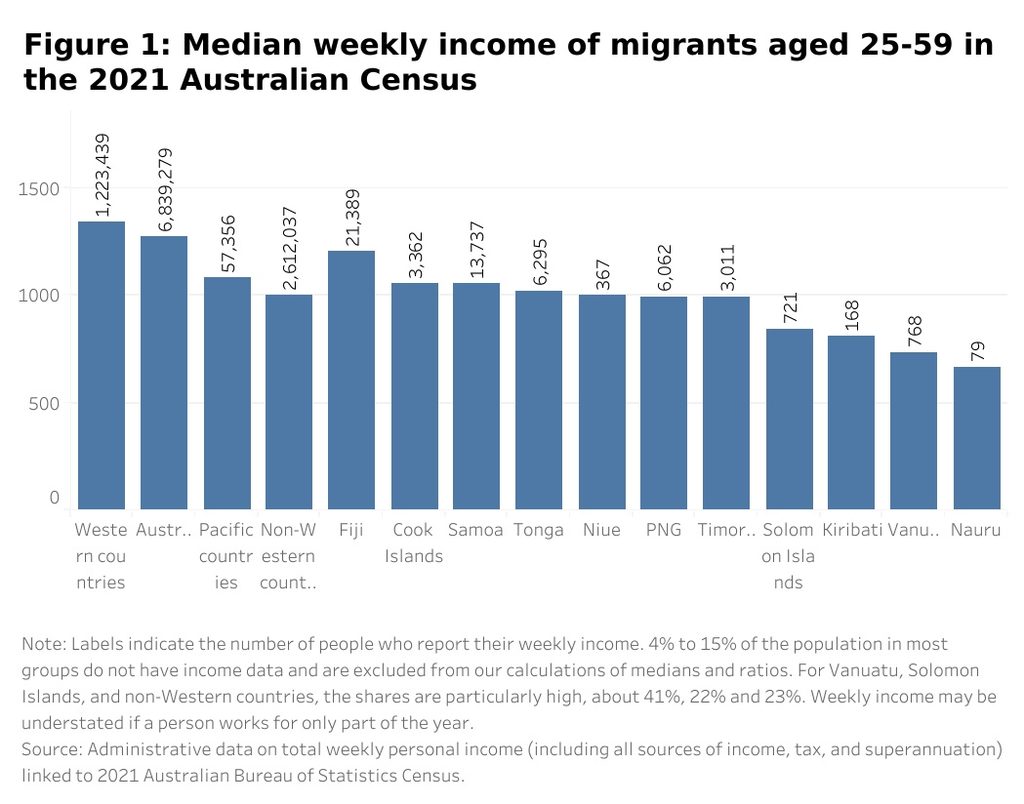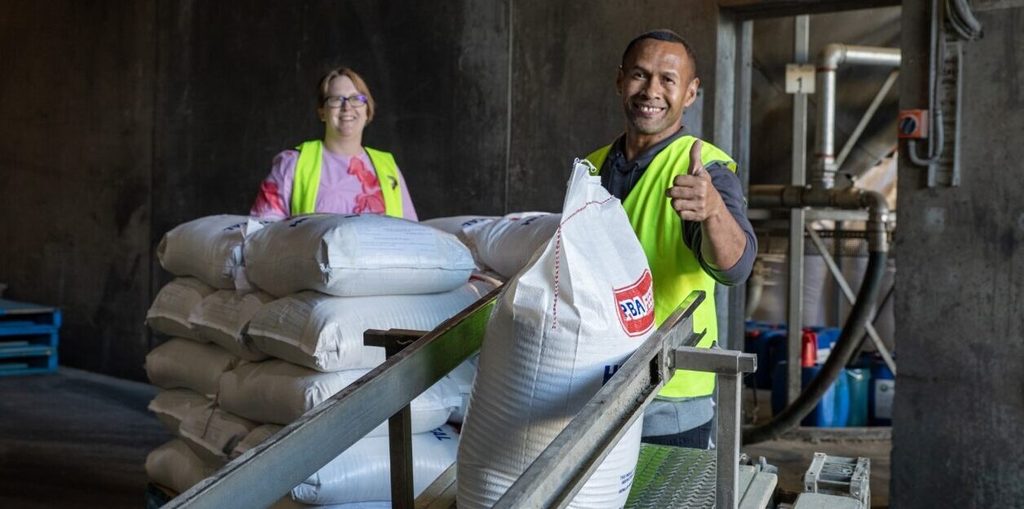Part 1 —
The first topic in Devpolicy’s Understanding Pacific communities in Australia article series was the age profiles of migrants from Pacific countries (including Timor-Leste).
We compared them to those from Western and other countries in Australia. We found that the average Pacific migrant is younger than those from Western countries due to a shorter stay in Australia, but older than the typical non-Western migrant due to a longer stay.
The second topic we will examine is the labour-market outcomes of Pacific migrants in Australia.
We are publishing our findings from an analysis of Australian Census data in two parts, with Part 1 covering income levels and employment status for those aged 25 to 59 years. Part 2 will focus on working hours and occupations.
Figure 1 shows that, in 2021, Pacific migrants had a median weekly income (including tax, superannuation and government support) of $AUS1085 or $F1597.54) (equivalent to $AUS56,420 or $F82,641.76 annually), lower than Western migrants ($AUS1345 or $F1970.10) and Australian-born workers ($AUS1275 or $F1867.57), but slightly higher than non-Western migrants ($AUS1005 or $F1472.08).
However, income levels vary significantly among Pacific migrant groups. Fijians earn the highest median weekly income at $AUS1205 or $F1765.04. Fiji’s large share of Pacific migrants raises the overall Pacific median; excluding Fiji, the figure drops to slightly above $AUS1000 $F 1464.76), aligning with non-Western migrants. Nauru, Vanuatu, Kiribati and Solomon Islands report the lowest median incomes, with Nauru’s median nearly half that of Fijians.
When restricting the population to those with Australian citizenship (to exclude temporary migrants), the median weekly income increases — by 8 per cent for Pacific migrants, 7 per cent for Western migrants and 18 per cent for non-Western migrants. While the income gap between Pacific migrants (including Fijians) and the Australian-born population narrows, Pacific migrants still earn the least among the four groups.
A key driver of the income gap is the lower share of high earners among Pacific migrants. Only 13 per cent of Pacific migrants earn over $AUS2000-($F2929.52) per week ($AUS104,000 – $F152,335.04 annually), half the rate of Australian-born individuals and Western migrants, and lower than non-Western migrants (18 per cent). Meanwhile, 11 per cent of Pacific migrants earn less than $AUS200-($F292.95) per week (just over $AUS10,000-$F 14,647.60 annually) — a level often regarded as insufficient for living in Australia.
In contrast, only 6 per cent of Australian-born individuals and 1 per cent of Western migrants fall into this category. Non-Western migrants have a slightly higher share in this category (12 per cent), but this group also has a larger proportion of students compared to Pacific migrants (13 per cent vs 8 per cent).
Among Pacific migrants, low-income rates are highest for migrants from Nauru (32 per cent ), Solomon Islands (29 per cent), Kiribati (27 per cent) and Vanuatu (21 per cent). Even for Fijian migrants, over 9 per cent earn below the low-income threshold, highlighting the financial challenges many Pacific migrants face in Australia.
The share of the population who are unemployed is similar across migrant groups, at around 4 per cent. Low labour-force participation is a key barrier to Pacific migrants’ income performance, with 21 per cent not working (either unemployed or not in the labour force) — higher than for Australian-born and Western migrants.
More than 25 per cent of migrants from Tonga, Cook Islands, Nauru and Samoa are not participating in the labour force: they are neither working nor seeking work. Many of them rely on government support — 21 per cent of Nauruans, 20 per cent of Cook Islanders, 19 per cent of Samoans and 16 per cent of Tongans — all above the 14 per cent average for Pacific migrants and Australians.
In contrast, migrants from Vanuatu and Solomon Islands have high employment rates but lower wages. Most rely on wages and salaries, with nearly all earning below $200-($F292.95) per week while engaged in agricultural work.
In summary, Pacific migrants in Australia generally earn less than Australian-born individuals and migrants from Western countries, with Fiji being a notable exception. They have a higher share of low earners, so are underrepresented in high-income groups. This is driven by low labour-force participation and lower wages in occupations where Pacific workers are concentrated. Part 2 will explore these occupations in more detail.
Read the Understanding Pacific communities in Australia article series at devpolicy.org.
Disclosure: This research was supported by the Pacific Research Program, with funding from the Department of Foreign Affairs and Trade. The views are those of the authors only.
This article appeared first on Devpolicy Blog (devpolicy.org), from the Development Policy Centre at The Australian National University.
n HUIYUAN (Sharon) LIU is a research officer at the Development Policy Centre, working in the area of labour mobility.
n TOAN NGUYEN is a Research Fellow at the Development Policy Centre, Crawford School of Public Policy, ANU. The views expressed in this article are that of the authors and do not reflect the views of this newspaper.
1

Toan Nguyen

HUIYUAN LIU



